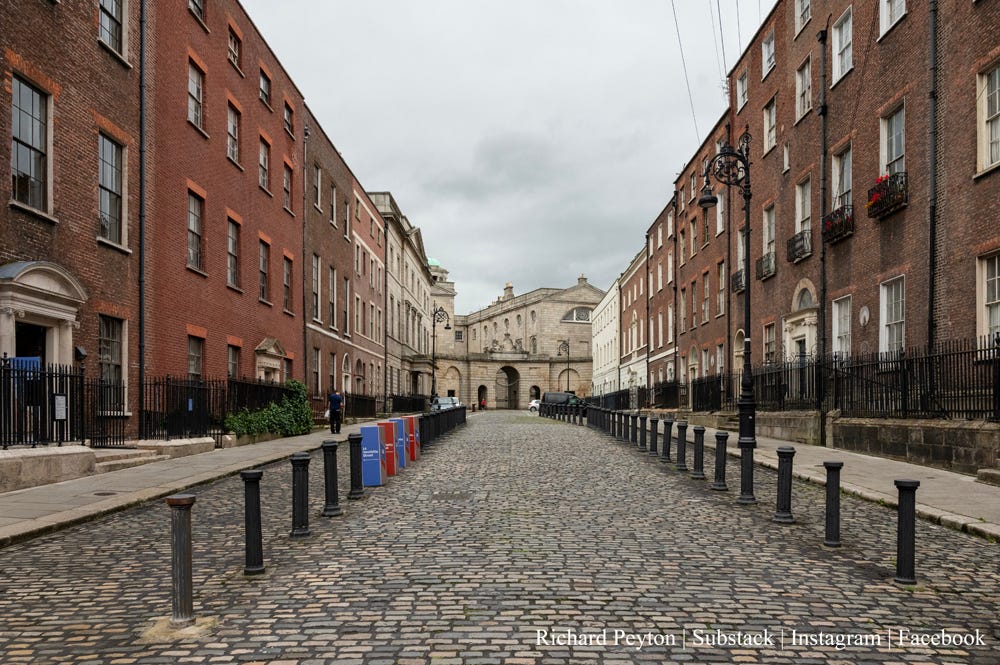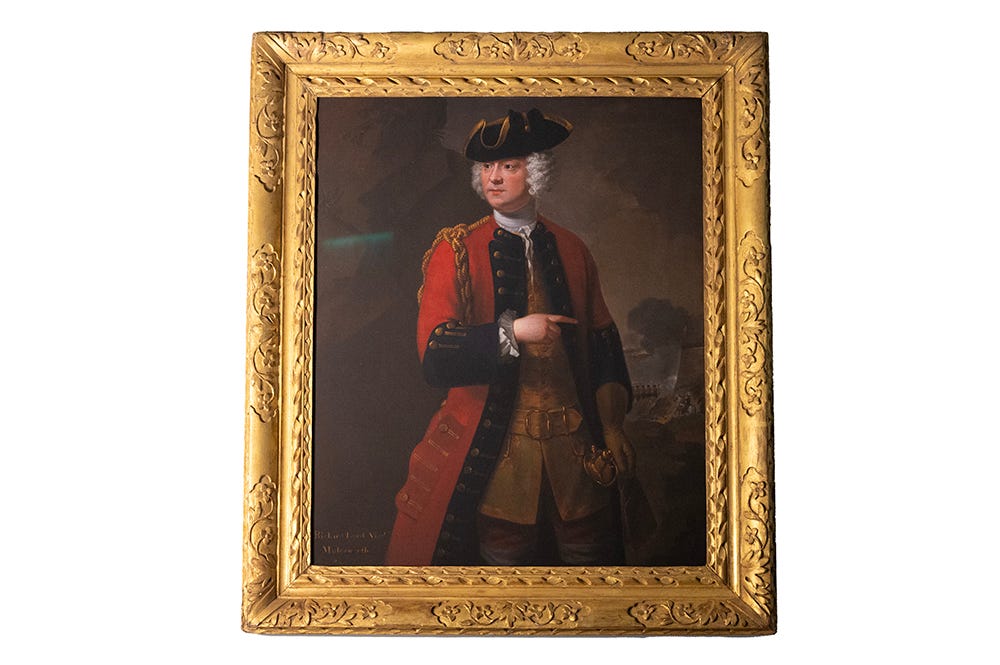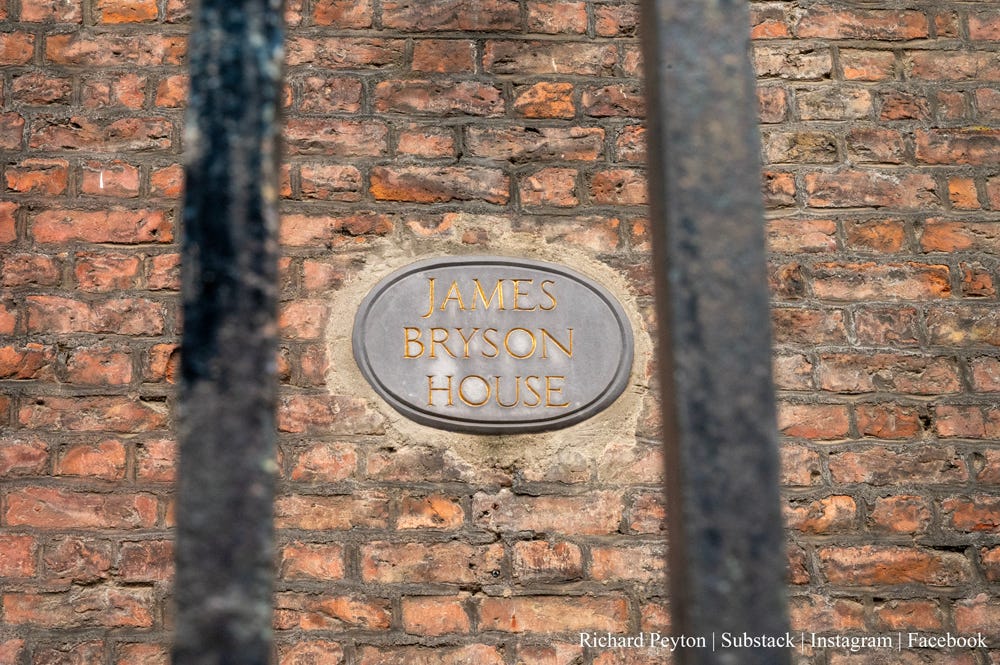One Day on Henrietta Street, Dublin
From the dwellings of elites to working class tenements with 100 people per house, this is a brief account of my recent visit to a street that is roughly 300 years old.
“Are ya married?” she asks me.
“No,” I say.
“Are you one of them gays?” she asks.
“No,” I laugh.
“Maybe one of them trans?”
Again, I reply “No” and she says, “Well, you’ve lovely long hair. I bet you wash that with Johnson’s baby shampoo,” and she’s got me there, as I actually do. She then offers me a cigarette and I tell her that I quit more than ten years ago and I say that I don’t know how anyone can even afford to smoke these days and she says she buys them off the street vendors for only six quid a packet.
She asks my name and I ask hers and then I ask if I could take her photo and she declines with, “Ah, go away outta da” in her thick Dublin accent.
“Are you a photographer?” she asks and I say, “Well, I have a camera,” and she says, “Sure for all I know you could be the biggest gangster in Dublin,” at which I laugh.
“Have you ever killed anyone?” she asks. “No,” I say, “have you?” and she replies with a laugh, “I don’t think so, but if I did, I don’t remember.”
This was not the sort of conversation I expected to have today, but I tell her it was nice talking to her and proceed over to the Henrietta Street Museum, which is in number 14. I got talking to her by chance as she was sitting on the steps outside one of the houses on the street and I thought she’d make for an interesting portrait.
Henrietta Street, a street of Georgian town houses, and once the most fashionable street in the city of Dublin, was built in the 18th century on land owned by a self-made man of obscure origins called Luke Gardiner, who at the age of 21, married 14-year-old Anne Stewart, who was the daughter of a viscount. The street was named after Henrietta, Duchess of Grafton, wife of Ireland’s Lord Lieutenant at that time. It became the prototype for the further development of Dublin which was the second city of the British empire. At the time, Belfast’s population was 8,000, and Manchester had a population of about 20,000. Dublin was the sixth largest city north of the Alps by 1750 and one of the wealthiest.
In its early days the houses of Henrietta Street were occupied by some of the elites of Irish society and occupants included generals, bishops, and politicians but, 120 years after their construction, they became tenements within which as many as 100 people lived at any one time. Interestingly, in more recent years, it has been used by television production companies as the backdrop of series’ and films about the likes of Jack the Ripper, and a production of Oscar Wilde’s Dorian Gray, as apparently it captures the essence of Victorian London better than anywhere in modern London.
One of the houses on the street, number 14, has been transformed into a museum and there are various times throughout the day where one can book a tour so as to experience a little bit of Dublin’s history with the help of a tour guide for the sum of €10, which is quite reasonable when one considers such a sum will not even cover two coffees in some cafes these days. I think €10 for a museum within which someone might learn something is far better value than chugging caffeinated beverages which only ever made me excessively nervous, giddy, and generally fatigued anyway.
At the reception I am greeted by a cheerful young woman with long, straight, two tone hair. One side of her hair is a bright yellow colour, while the other side is bright red. She’s dressed in, if I recall correctly, chequered dungarees and so reminds me a little of a harlequin.
The tour takes us through various rooms in the house during which our tour guide, Gus, informs us of the history of the house at different times since it was built. In the second room of the tour, we (the group of visitors) are told a little about the first resident of the house we are standing in. A man named Viscount Molesworth, who had three children with his first wife moved in in 1751. When she died, he married a second time, at 63, to a Mary Jenney Usher who was aged only 15, and with her he had a further seven children. Taking such young brides was not uncommon around this time, even though it’s unthinkable today.
Gus informs us that the house would have been the scene of lavish social occasions among the people that lived in them, and that they would have been occupied from September to March as this was the parliamentary season. The occupants of the houses changed after the 1800 Act of Union, which merged the parliaments of the UK and Ireland, and so all of the residents of the street moved over to London and elsewhere and the houses became the properties of various solicitors between 1800 and 1860 after which time they became tenements for large and poor working-class families. In the 1860s there was 17 families in the 20 rooms of 14 Henrietta Street. And the 100 people therein had no running water and had only one toilet between all of them, which was only for use by men and boys. Disease was rampant and approximately 2/5 children did not make it to the age of 5 years old. The front door was always open, and so it was not uncommon for vagrants to enter the houses and sleep in the hallways.
The outsides of the houses have an appearance of grandeur, as do the first couple of rooms of the Henrietta Street Museum. However, as one is led through the house, the later rooms and hallways resemble more like how things would have looked when they became tenements, with the dreariest room being the basement, which was apparently the worst room in the house as it would have been colder and damper. Gus tells us that a regular visitor to the museum is one Patrick Brannigan, who was born in the basement room of this house in 1939 and, now in his 80s, is now a regular visitor. He is also a writer of two stage productions, called “I Thought you Were Dead” and “The Pawnshop”, the subject matter of which, apparently, concerns life in the tenements. Himself and his family moved out of the tenement in 1949 and in a podcast on the museum website (link in references section) he says that his mother was never again the same after moving out from there which he attributes to her missing the sense of community that existed in the tenements. To the modern person, it seems that 100 people living in only 20 rooms would evoke feelings of claustrophobia, but accounts of Peter Brannigan paint a picture of a supportive community which his mother greatly missed when she was not a part of it anymore, and this makes me wonder if a lot of people nowadays, where it seems there is a pandemic of depression, might be at least somewhat more content in their lives if they had a greater sense of being a part of a community.
Some of those that dwelt in Henrietta Street in the 1910s took part in the 1916 rising, while others enlisted in the British army to fight in World War I. It’s interesting that in the same street were men who fought against the British while others fought for the British, as a lot of Irish did as no doubt it was an opportunity of some kind of career where perhaps one did not exist otherwise. Donal Fallon, in his book “Three Castles Burning” notes that this “reflects the economic reality of Henrietta Street that it contributed more men to the British armed forces than to the ranks of the IRA”.
By the 1970s, all tenements had closed, and there were people who wanted them demolished as they felt they were nothing but a reminder of the colonial history of the city. But then a man named Uinseann MacEoin started acquiring properties in the street and started turning them into artist’s studios. On one of the houses on the street, number 5, there is a plaque which remembers a James Bryson, who was a high-profile IRA volunteer which in some sense doesn’t seem to fit with the British design, construction of the houses, and what they represent.
At the end of my tour in the museum, Gus says that if we enjoyed the tour to leave a positive review on Tripadvisor and to mention his name. He says that if we did not enjoy it that we could call him George, and everyone laughs. There was a treasure trove of interesting nuggets to discover on the tour, but I shouldn’t like to divulge too many spoilers to those that might wish to go there.
I leave the street, quite satisfied that in some sense I relived a period of history about a street I had never even heard of prior to a couple of months ago. Hundreds of thousands of people have no doubt walked up and down these streets over the years, and most are forgotten like they never even existed, as myself and the lady I chatted with at the start of this post will be. For 300 years people have lived, breathed, reared families, and died in the houses on this street, the same as any other street really, and any contemplation of it could only ever be vague and general, and scattered with the names of a few high-profile people who are ultimately forgotten the same way all of us are.
References
1. Gus, the tour guide 😊.
2. Three Castles Burning, by Donal Fallon.
3. https://14henriettastreet.ie/news-and-stories/teatime-talks/
4. O’Connell Street, The History and Life of Dublin’s Iconic Street, by Nicola Pierce.







